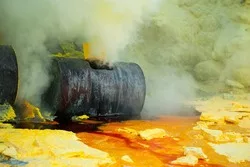
The most dangerously contaminated sites in the US are “Superfund” sites. There are, currently, 1,317 of them. New Jersey has the most-114-while California and Pennsylvania follow right behind. The map in this article identifies all of the Superfund sites and allows you to search for where such sites may be in your state. http://time.com/4695109/superfund-sites-toxic-waste-locations/
A plant or factory or waste dump, etc., is designated a “Superfund” site according to a federal formula that is specifically concerned with the ways in which toxic chemicals at the site might come into contact with, and hurt, human beings. So, for example, if an industrial plant years ago dumped chemicals which have migrated into area groundwater that local residents use for drinking and bathing, and/or if that contaminated groundwater produces a toxic vapor that might intrude into the breathing spaces of their homes, these threats weigh heavily in favor of determining that the plant should be a Superfund site.
The original idea of Superfund site designation in the 1980s was that the federal government would dedicate significant resources to cleaning up these sites, and protecting nearby residents from their threats. However, as time went by, our commitment to this important protection has flagged badly; today, many of these sites receive little or no government attention, even though nearby residents may remain in serious danger. Politically, both Democrats and Republicans have been complicit in this abandonment, largely because Superfund sites are typically found in poor and minority neighborhoods, and many politicians of both parties believe that there is little price to pay for ignoring their needs.
Indeed, this failure of our government to protect its most vulnerable citizens reached a new low just yesterday, as President Trump proposed a budget that would slash the already grossly inadequate Superfund clean-up resources by nearly 50%.
Hopefully, after you study this map, you will learn that you do not live near a Superfund site, and therefore that your family’s well-being is not threatened by the calculated neglect of your government.

"*" indicates required fields